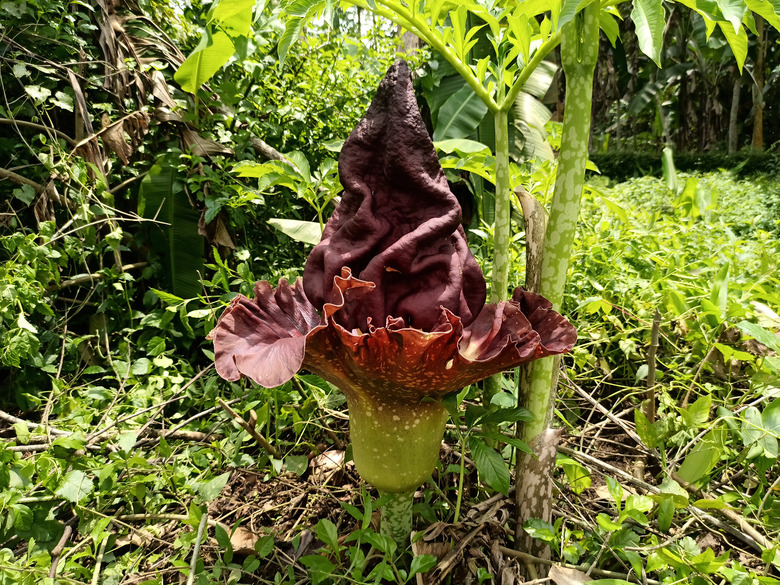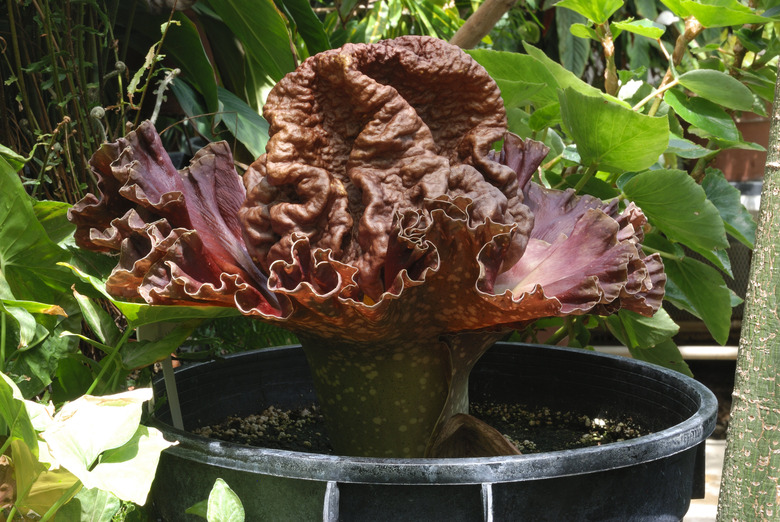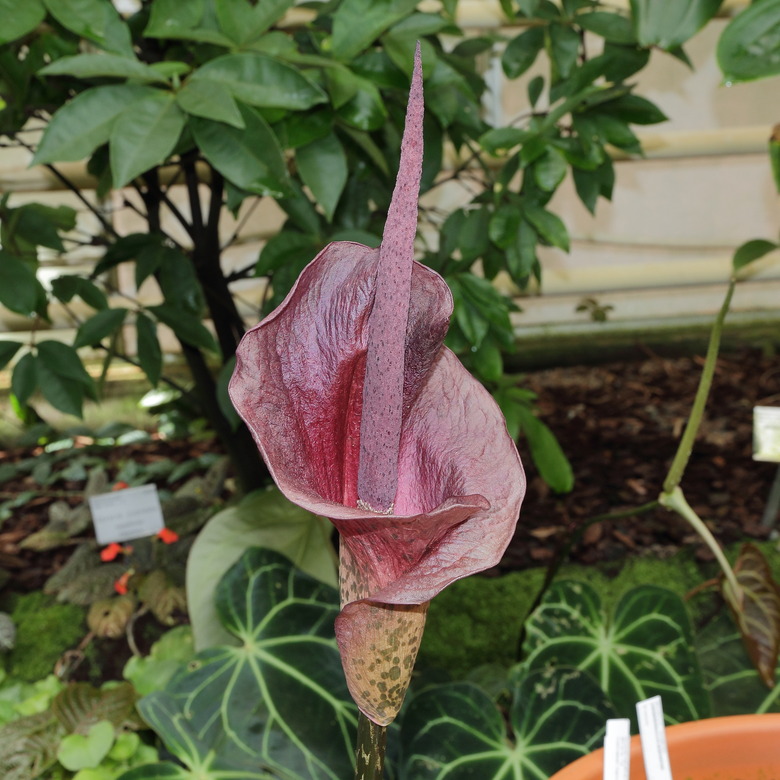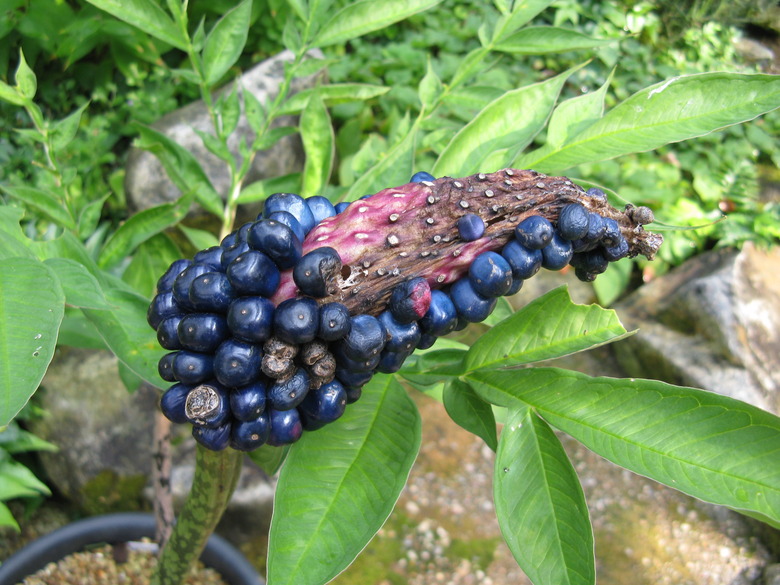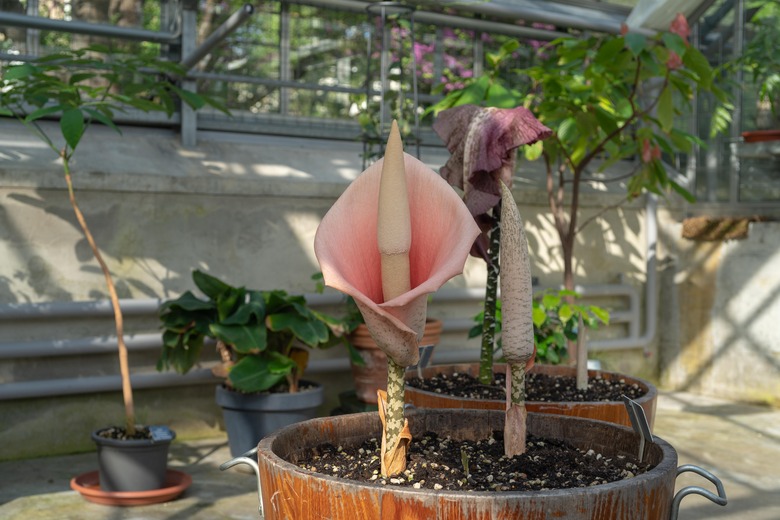Different Types Of Voodoo Lilies
Voodoo lilies (Amorphophallus spp.) rarely make an appearance in home gardens, although they are sometimes sought by adventurous gardeners with a taste for the unusual. Sometimes called corpse flower or devil's tongue, these sensitive tropical plants bloom sporadically and produce a single large, fleshy flower that emits a smell similar to rotting meat.
Roughly 170 species of flowering plants belong to the genus Amorphophallus, most of which share the common name voodoo lily. However, only a handful of voodoo lilies are grown by gardeners, because they are picky about their growing conditions and may not be suited to every household because of their smell.
Warning
Voodoo lilies contain oxalate crystals that can cause illness and injury if consumed.
About Voodoo Lilies
All voodoo lily varieties share traits in common. They are aroids, which means that they belong to the Arum family, Araceae.
Voodoo lilies grow from tubers or corms, which are fleshy structures similar to large bulbs. Each spring, the tuber sends up a tall inflorescence that blooms before the plant sprouts leaf stalks and foliage.
Voodoo lily flowers vary in appearance between species but they have some similarities. Most have a central purplish spadix, which is a spear-shaped structure covered in tiny flowers. The spadix is surrounded by a spathe, which is a whorl of fleshy, vase-shaped structures reminiscent of a calla lily flower.
Tip
The flowers emit a powerful, unpleasant odor to attract pollinators, but the smell disappears after the flower is pollinated.
Types of Voodoo Lilies
Only a few types of voodoo lily plants are commonly grown by gardeners and exotic plant collectors around the world.
Elephant Yam
Amorphophallus paeoniifolius, which is known either as voodoo lily or elephant yam, is among the more common varieties grown by tropical plant enthusiasts. It grows best in USDA hardiness zones 11 to 12, so it is only suited to outdoor cultivation in the warmest frost-free climates.
Elephant yams produce umbrella-like foliage on a straight, mottled stem, as well as a large, wrinkled purple flower with a powerful odor. This plant also forms a large tuber that contains a high concentration of oxalate crystals, which make it inedible when raw.
Konjac Plant
The konjac plant (Amorphophallus konjac) is a voodoo lily variety grown for its lush foliage and eye-catching, spotted stems. It grows outdoors in USDA zones 6a to 11b, making it one of the more cold-hardy voodoo lily species. Konjac plants produce a large, pinkish-purple flower in spring, which some growers opt to remove due to its intensely unpleasant odor.
Konjac plants are grown as ornamentals but are also widely cultivated in Asia for their tubers. The tubers are poisonous when raw but can be processed and cooked to produce a variety of foods.
Devil's Tongue
The devil's tongue (Amorphophallus kiusianus) grows best in USDA plant hardiness zones 7a to 10b. It reaches a mature height of 2 to 4 feet with a 2- to 3-foot spread. Devil's tongue flowers are a dull olive green color that is not especially eye-catching, although the flowers are just as strong-smelling as other voodoo lily varieties.
The flowers morph into a stalk of shiny berries that range in color from reddish-pink to almost black. The berries are very showy and will last several weeks, brightening up the plant for the remainder of the growing season.
Snake Plant
The showy, slightly-less-smelly snake plant (Amorphophallus bulbifer) grows best in USDA plant hardiness zones 7b to 11b. It forms a 3-foot-tall flower that shifts in color between green and pink. The flower is not as heavily scented as other Amorphophallus varieties, but it still has a persistent carrion-like scent until it is pollinated.
Pollinated devil's tongue flowers develop into a stalk of highly ornamental red berries that will persist during the summer months. The non-blooming leaf stalks are also ornamental because they are covered in an intricate, mottled pattern reminiscent of snake skin, which earned this plant its common name.
Growing Voodoo Lilies
Voodoo lilies need the right growing conditions and care year round to produce their characteristic flowers.
Growing Conditions
- All voodoo lily varieties grow well in partial shade. Some full sun exposure in the morning is fine for most voodoo lilies, but direct sunlight at midday will scorch the flowers and foliage, especially in young plants. Deep shade is also well tolerated by voodoo lilies, but it may make their foliage less vivid and may inhibit blooming.
- Voodoo lilies need moist, well-draining soil of moderate fertility to provide the right conditions for blooming. Amend the soil at the growing site with aged manure or compost. Growing these plants in pots filled with rich potting soil is a good idea, because it will both provide the right soil and will also allow you to move the plant indoors during cold weather.
- Warmth is important for voodoo lilies. Most need temperatures above 68°F to grow well outdoors during the summer months, so grow them in a sheltered position in the garden or in a pot so that they can be moved to shelter during cold weather.
Caring for Voodoo Lilies
Voodoo lilies are relatively low-maintenance plants, if they are grown under the right conditions.
**Watering Voodoo Lilies:** Voodoo lilies love very moist soil and should be watered whenever the soil surface feels nearly dry, especially during their bloom time. Taper off watering in late summer to allow the plant to enter dormancy.
**Feeding Voodoo Lilies:** Fertilizer is needed when growing voodoo lilies in unamended soil. Provide a monthly feeding of high phosphate fertilizer such as 15-30-15 from early spring until just after mid-summer, which will encourage strong tuber growth and better blooming the following year.
**Overwintering Voodoo Lilies:** Overwintering voodoo lilies is an important part of their care in cooler climates. In frost-free areas, they need no special care during the winter months and will return in early spring with renewed growth. In colder climates, the tuber should be dug up and potted in late summer, then overwintered in a warm, bright room in your home.
Cold-tolerant voodoo lilies can be overwintered in the garden in zone 6. Cover the voodoo lily bulb or tuber with a 5-inch-thick layer of straw or compost to keep the soil from freezing during cold weather. Remove the covering after all frost danger has passed.
References
- University of Florida IFAS Extension: The Voodoo Lily
- Plants for a Future: Amorphophallus Paeoniifolius
- North Carolina State University Extension: Amorphophallus konjac
- Wisconsin Horticulture: Voodoo Lily
- North Carolina State University Extension: Amorphophallus kiusianus
- Annie's Annuals: Amorphophallus bulbifer
- International Aroid Society: The Cultivation of Amorphophallus
